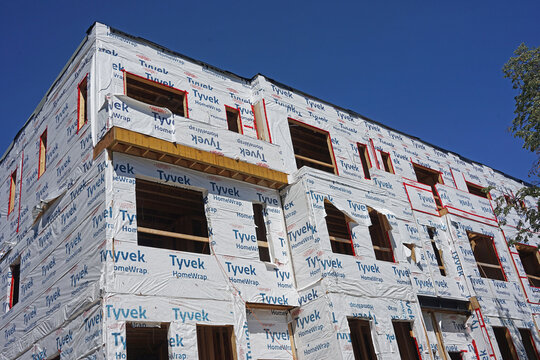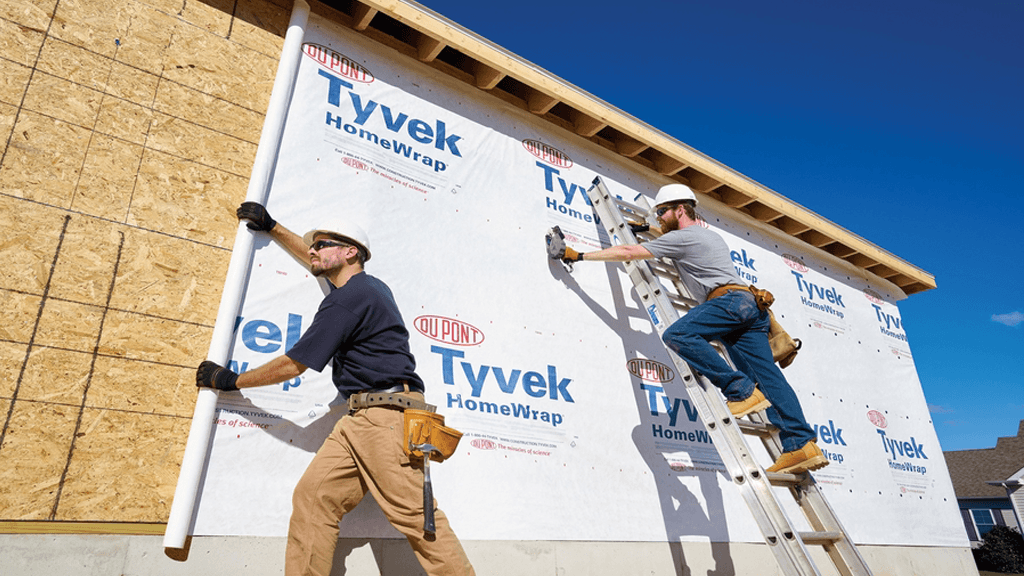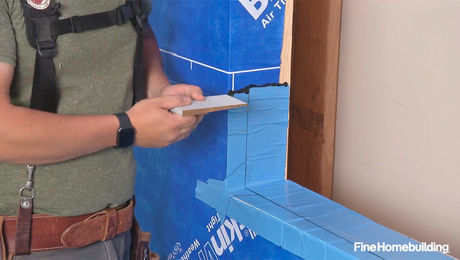In the world of construction and home improvement, ensuring that your house is well-protected from the elements is paramount. One of the essential components of this protection is the water-resistant barrier, often referred to as housewrap. This comprehensive guide will take you on a journey through the world of housewraps, their functionality, necessity, and the best choices available. Get ready to delve into the world of construction, and let’s start by understanding how housewrap works.
Understanding the Functionality of Housewrap: How Does It Work?

The Basics of Housewrap
Before we jump into the nitty-gritty details of housewrap functionality, let’s start with the basics. Housewrap is a synthetic material that is applied to the exterior walls of a building before the siding is installed. Its primary purpose is to act as a protective barrier against moisture infiltration. But how exactly does it achieve this?
Water Resisitance
Housewrap’s core function is to prevent water from seeping into the walls of your home. It acts as a shield against rain, snow, and other forms of moisture.
Breathability
While it keeps water out, housewrap allows water vapor to escape. This breathability is crucial because it prevents trapped moisture within the walls, which can lead to mold and rot.
UV Resistance
Housewrap is designed to withstand exposure to sunlight without degrading. This UV resistance ensures that the barrier remains effective over time.
Drainage
Some housewraps have built-in drainage channels or patterns that help direct water away from the wall, further enhancing their moisture-resistance.
Now that we’ve covered the basics, let’s move on to the big question – is housewrap essential for your home?
Is Housewrap Essential for Your Home? Exploring Its Necessity
The Importance of Housewrap
Housewrap isn’t just an optional add-on for your home; it’s a crucial element that can have a significant impact on your building’s longevity and energy efficiency.
Moisture Protection
Over a regular stud-framed wall you have exterior sheathing and then the exterior material. Most exteriors allow some moisture to get through. If the moisture gets to the sheathing underneath, it can lead to rot, mold growth, and even compromise the strength of the building materials. Housewrap protects the exterior sheathing from moisture.
Energy Efficiency
Housewrap acts as an additional layer of insulation. It helps keep your home warm in the winter and cool in the summer, reducing your energy bills.
Code Compliance
Many building codes and regulations require the use of housewrap in new construction. Ignoring this requirement can result in costly legal issues.
Resale Value
Homes with proper moisture barriers and energy-efficient features tend to have a higher resale value. It’s an investment that pays off in the long run.
So, now that you know the importance of housewrap, let’s dive deeper into the types of housewraps available and how they compare.
Distinguishing Housewraps: Are They Created Equal?

Tyvek Housewrap
Tyvek is probably the most well-known brand in the world of housewrap, and for a good reason. It’s made from high-density polyethylene fibers and is known for its durability and performance.
Tyvek Housewrap Benefits:
Firstly, Tyvek is prized for its breathability, allowing moisture vapor to escape from the wall assembly, which can help prevent moisture-related issues. Moreover, it is often more cost-effective than Blueskin, making it a preferred choice for projects with budget constraints. Contractors find Tyvek easier to install due to its lightweight nature and ease of rolling out, contributing to its popularity. Tyvek is also versatile, suitable for a variety of climates and construction types, enhancing its applicability.
With greater UV resistance, Tyvek can withstand prolonged exposure to sunlight without deterioration. Some siding materials adhere better to Tyvek, simplifying installation, and it often meets or exceeds building code requirements. Furthermore, Tyvek has a proven track record for durability and reliability, coupled with wide availability at construction supply stores. In case of damage, Tyvek is generally more repairable, typically requiring patches or tape for fixes, as opposed to potentially more complex solutions with Blueskin.

Blueskin Housewrap
Blueskin housewrap is another top contender in the market, known for its innovative technology and moisture protection capabilities.
Blueskin Housewrap Benefits:
Firstly, Blueskin excels as an air barrier, creating a more effective seal against air leakage, making it particularly valuable when airtightness is a paramount concern. Its self-adhesive nature simplifies installation, ensuring a tighter seal around openings and seams, reducing opportunities for air or moisture infiltration. Blueskin’s inherent waterproofing capabilities make it a preferred option in regions with heavy rainfall or when robust moisture resistance is critical. It also functions admirably as a vapor barrier, preventing moisture from entering the wall assembly when such protection is needed.
Renowned for its durability and ability to endure harsh weather conditions, Blueskin provides long-lasting protection. Its flexibility and adhesive properties allow it to conform seamlessly to irregular surfaces and architectural details, ensuring continuous protection. Blueskin’s good UV resistance guarantees that it maintains its integrity even when exposed to sunlight for extended periods. With a strong focus on seam integrity and suitability for severe weather conditions, Blueskin emerges as a reliable choice in regions prone to extreme weather events.
Which One Should You Choose?
Tyvek tends to shine in situations where breathability is crucial. In climates where moisture control within the wall assembly is a top priority, Tyvek’s ability to allow moisture vapor to escape makes it a preferred choice. Its cost-effectiveness can also make it the right pick for projects with tight budgets. Contractors often appreciate Tyvek for its ease of installation, making it particularly suitable for projects requiring quick turnaround times. Its versatility across different climates and construction types adds to its appeal. Tyvek’s greater UV resistance ensures its longevity in sunny locales. Additionally, its wide availability at construction supply stores and repair-friendliness with patches or tape can be beneficial.
On the other hand, Blueskin excels in scenarios where airtightness is paramount. Its self-adhesive properties simplify installation and lead to tighter seals around openings and seams, reducing air and moisture infiltration. Blueskin’s robust waterproofing capabilities shine in regions characterized by heavy rainfall or when moisture resistance is critical. It functions admirably as a vapor barrier, preventing moisture from penetrating the wall assembly. Its durability and ability to withstand harsh weather conditions make it suitable for long-lasting protection. Blueskin’s flexibility and adhesive nature enable it to conform seamlessly to irregular surfaces and architectural details, providing continuous protection. In regions prone to extreme weather, Blueskin’s focus on seam integrity and suitability for severe conditions make it a reliable choice.
Ultimately, the choice between Tyvek and Blueskin should align with the project’s specific needs and the prevailing climate conditions. Each product offers distinct advantages, tailored to different requirements, ensuring that the housewrap selected is best suited to deliver effective protection and performance.
Get Your Housewrap Questions Answered
Do I Need Housewrap If I Have Siding?
Yes, housewrap is still necessary even if you have siding. Siding is not a waterproof barrier, and moisture can penetrate it. Housewrap provides an additional layer of protection.
Can I Install Housewrap Myself?
While it’s possible to install housewrap as a DIY project, it’s crucial to follow manufacturer instructions carefully. Improper installation can compromise its effectiveness.
How Long Does Housewrap Last?
Housewrap can actually last as long as your home does. Since it is installed between the exterior sheathing and the exterior material, it remains protected for a very long time.
Can I Paint Over Housewrap?
Some housewraps are paintable, but not all. Tyvek and Blueskin are both paintable. Check the manufacturer’s recommendations before painting.
Housewrap is a vital component of your home’s protection against moisture and energy loss. Choosing the right housewrap depends on various factors, including your climate, budget, and installation preferences. Whether you opt for the durability of Tyvek or the innovation of Blueskin, investing in quality housewrap is a decision that pays off in the long run, ensuring your home stays comfortable and structurally sound for years to come.


111 Comments
Comments are closed.